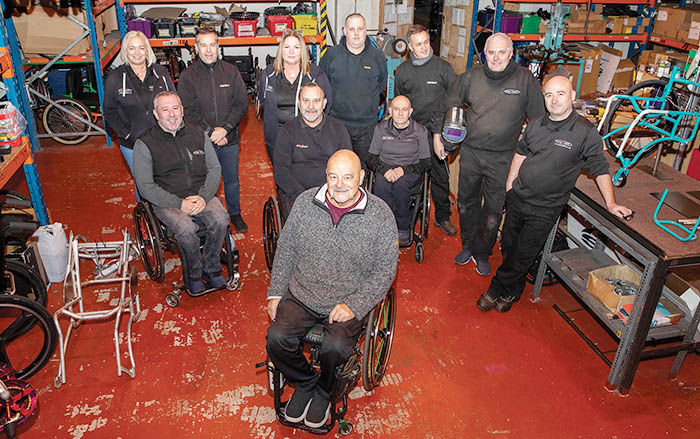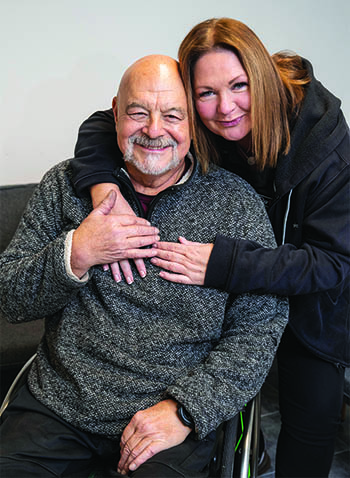WORKING WONDERS: Vinny Ross and the team at DaVinci Mobility, and below, with wife, Mary. Pictures: JASON ROBERTS
“You’ve just got to make the most of what you have . . .” says Vinny Ross
GERRY CORNER meets the social entrepreneur who has spent 50 years helping paralysed people to rebuild their lives
A MIRROR fixed to his hospital bed allowed Vincent Ross a view of the hubbub in the courtyard behind him.
In the weeks following a road accident that abruptly reshaped his future, the reflected images of lively wheelchair basketball games were pretty much all that passed for entertainment.
But while the 22-year-old lay on his back, immobile, and came to terms with a body damaged beyond repair, that mirror allowed him a glimpse of something else too – the mindset he would need for life in a wheelchair.
“I was in a bit of a dark place after the accident,” recalls Vinny, from Liverpool and now 70, of his time at Southport Spinal Unit.
“A lot of people were coming in while I was there, who had psychological problems, who had just not got over it, and they died. “But I noticed the ones involved in wheelchair sports were far more positive. They would come and have a chat with you, whereas the others were in a bad way.
“I gradually realised there were only two ways to go. And the only thing to do was make the best of what you’ve got.”
He’s done that all right. As a two-time Paralympian, with a bronze medal to his name; as an adventurer, whose wheelchair exploits include paragliding, skiing, hand-biking from Land’s End to John O’Groats and across Japan, and solo trips to Vietnam and China; and as an inventive, award-winning entrepreneur, supplying equipment to the likes of sporting superstar Tanni Grey-Thompson, and devoting himself to improving the lives of other wheelchair users.
At 22, Vinny was a newly-qualified toolmaker with a penchant for motorcycles and “just getting on with my life. I was motorbike mad, rode everywhere and did a bit of racing.”
One day in January, 1974, he was the front passenger in a car that ran out of control on Queens Drive, Liverpool, and rolled onto its roof.
Vinny sustained a compression dislocation of the spine. The driver – “my best mate” – came out with cut fingers.
“The roof collapsed on the back of my shoulders and I was folded over him in the front seat.
“It wasn’t his fault. Well, I say it wasn’t his fault; he was driving the car, so it was his fault. But we’d done all sorts of things together.
“I had hit the back of a car on my motorbike, he went right over my head and landed on the bonnet. Fortunately, he wasn’t seriously hurt.”
Recovering in the spinal unit, the spirit of those wheelchair basketball players, fresh back from their exploits in the New Zealand Commonwealth Games, galvanised the young Vinny and has infused everything he has achieved since.
Focusing on what can be done, and not what can’t. “I’d had a pretty positive outlook on life anyway, a glass half full person.”
He was back at work in little more than seven months and by now an enthusiastic wheelchair basketball player himself, extraordinarily finding himself in the GB team for the Montreal Olympics less than two years later.
“We didn’t do very well. But if you did two sports you had more of a chance of going. So, I was also fencing and won a bronze medal.
“From having no sort of direction in what I was doing, getting involved in wheelchair sport completely changed my life.”
The GB wheelchair basketball team’s efforts at the 1974 Games were not helped by having to compete in crudely functional chairs. That changed with Vinny’s involvement.
“It was the same sort of chair that wheelchair services gave out: very high back rest, push handle sticking out the back, they had immoveable footrests, they folded up – all the things you don’t want on a chair for sport.
“I noticed the Americans had gadgets to make their chairs more useable; a gizmo that moved the wheels further forward to make it more manoeuvrable, some of them had a camber on the wheels, which makes it much more stable and turn a lot faster,
“Because I was working in a massive factory with all the equipment, I started fiddling about with my chair to make it more useable.
“Then when we went to another tournament I noticed some of the Americans actually had chairs made out of aluminium tubing so when I came back I made one of them. and then I made one for one of the other lads in the team, and then another one. By the time we got to the 1980 Paralympics, the whole team was playing in chairs that I’d made.”
More recent Paralympians also have reason to be grateful for Vinny’s mantra that “it can always be better”. Wheelchair racer Hannah Cockroft (eight golds at London, Rio and Tokyo), table tennis star Jack Hunter-Spivey (bronze in 2020), and legendary athlete turned Parliamentarian, Tanni Grey-Thompson, have all benefited from his expertise.
After his experiences with the GB wheelchair basketball squad, Vinny began creating custom-made wheelchairs – first from the garage of his home, later while working for a charity, and then, in 2001 launching DaVinci Mobility with friend John Ingram, at the Gilmoss Industrial Estate in Fazakerley.
In the couple of decades since, DaVinci has become one of the UK’s most respected wheelchair makers, and quietly gone about the business of improving countless disabled people’s lives.
Along the way they have constructed a special vehicle allowing a paralysed farmer to reach fields he had never seen before; another for a 92-year-old in Cornwall “perfect for getting him up the hills from the beach”; and proving wrong the occupational therapist who insisted an 18-month-old girl with cerebral palsy would never be able to push a chair.
“She was terrified when she saw me, but we got her sat in a tiny chair, and by the time I left about an hour later she was chasing me round the room in it.”
For many, Vinny and his dedicated team at DaVinci, are the difference between a life making do in a bog standard, NHS-provision wheelchair (“enough,” one man with a spinal injury notes, “for someone sitting in the house all day”) and a life that is active and fulfilling.
Vinny said: “Most people who need a wheelchair need something that’s tailored to their needs because every person with a disability is different, the disabilities affect them in different ways, they are all different sizes, and their requirements from the chair are completely different.
“Even millimetres can make a big difference and give you access to a lot more places.”
His methods, the attention to detail, each chair a one-off, means he is never going to “make millions”. Instead, his motivation is “purely to make life better for anybody else that’s in my situation or similar.
“Basically we solve problems for people. When they come in and they want to be able to do something then, yes, we can do it. it might take a bit of time, and we might have to fiddle about with it for a while, but usually we can make it work for people. And, yeah, if we can make a living while we’re doing it, great.”
While other companies producing totally bespoke wheelchairs perished, DaVinci survived lockdown, with Vinny insisting throughout on making up the difference between furlough and the rest of the wages for his workforce, many with a disability of their own.
At 70, he has reduced the time he devotes to DaVinci: “I’m working to keep this place going basically, If there are any grants or anybody out there who’s interested in what we’re doing, and they’re interested in helping out, I’d like to reach out and have a talk with them.”
Looking ahead, he hopes to develop DaVinci’s relationship with Alder Hey Children’s Hospital, providing wheelchairs for muscular dystrophy patients. But, as always, the funding is hard to come by.
“There is a brief window in the life of a muscular dystrophy patient when they can use a wheelchair. But then if you apply to a charity, it goes on and on and on and sometimes it can take a year or more, by which time these kids can’t use it anymore.”
Back in 1974, barely into adulthood, Vinny was told he would not make it to middle age, and would never have children.
Wrong on both counts. Vinny has been married to Mary (a fellow director of DaVinci, pictured here with Vinny,) and the couple have two children, twins – Nat and Nell – aged 16.
Meanwhile, he has long surpassed the lifespan predicted for him. “After the accident my insurance company and the doctor who advised them, gave me 15 years’ life expectancy.
“So, it was always in my mind that I wasn’t going to live that long, and I did some pretty crazy things. I mean really crazy things. I’ve had a paragliding licence, raced all kinds of cars, put hand controls on to a car in the snow in Denver and drove into the Rockies to go skiiing.”
Despite some hairy moments along the way, “it never bothered me, I loved it in fact”.
An adventurous lifestyle has come at a cost and he faces two shoulder operations. “Pushing a wheelchair takes its toll over the decades, plus pushing to the limits physically.”
He does not consider what might have been had he not found himself being carried in a car along a Liverpool ring road 48 years ago. “I don’t dwell. because what can I get out of it?”
“Besides,” he adds, “I think everything that I’ve wanted to do I’ve actually done.
“One of the worst things about being in a wheelchair is that there is always this carrot, dangling on a string, of a potential cure. They have talked about it since I was in a chair.
“That is so frustrating. If it happens, ok, but the best thing I can say to anybody is, please, get on with your life.
“A lot of people feel like they’ve lost everything, but at the end of the day you’ve got to rebuild it.
“And the only way to do that is to have a positive outlook on things and find something that you CAN do, and enjoy doing, and follow that path.”



